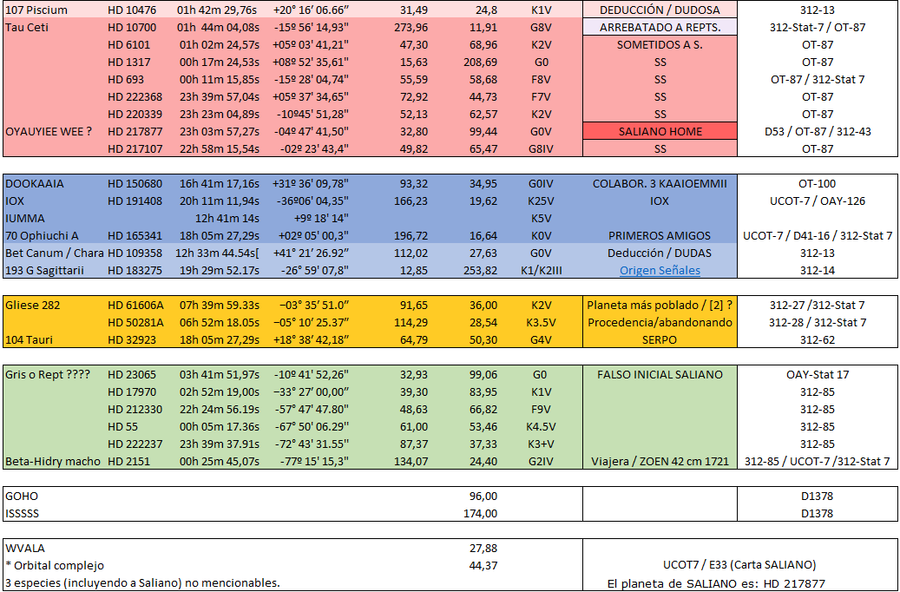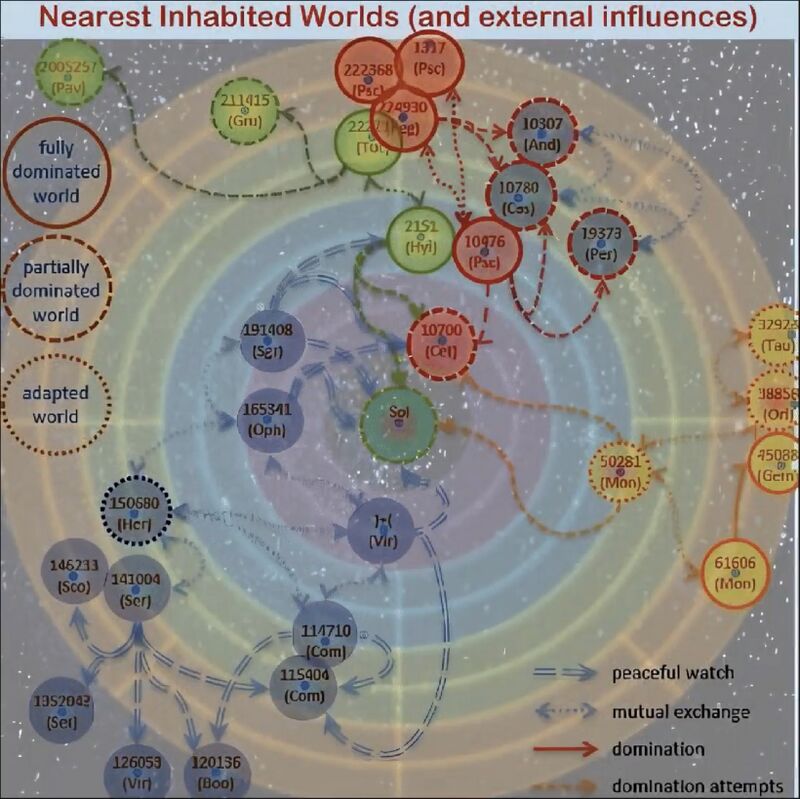Ethnies proches impliquées : Différence entre versions
(→Groupe ORANGE) |
|||
| Ligne 85 : | Ligne 85 : | ||
Habitable Zone: Depending on atmospheric properties, up to two planets (e and f) may be located within the habitable zone of HD10700 at its current estimated age of 7.63 billion years. | Habitable Zone: Depending on atmospheric properties, up to two planets (e and f) may be located within the habitable zone of HD10700 at its current estimated age of 7.63 billion years. | ||
Stellar Activity: The star’s radial velocity (RV) measurements have been affected by stellar activity, which can impact exoplanet detection. A recent study used a convolutional neural network to mitigate this effect and achieve detection thresholds as low as 0.5 m/s in semi-amplitude for planets with periods ranging from 10 to 300 days. | Stellar Activity: The star’s radial velocity (RV) measurements have been affected by stellar activity, which can impact exoplanet detection. A recent study used a convolutional neural network to mitigate this effect and achieve detection thresholds as low as 0.5 m/s in semi-amplitude for planets with periods ranging from 10 to 300 days. | ||
| + | |||
| + | ==10976 (10476?) == | ||
| + | |||
| + | ==224930 | ||
| + | |||
| + | ==1327 | ||
| + | |||
| + | ==222368 | ||
| + | |||
| + | |||
| + | ='''Groupe GRIS (Partiellement dominés)'''= | ||
| + | |||
| + | ==10307== | ||
| + | |||
| + | ==10780== | ||
| + | |||
| + | ==19373== | ||
='''Groupe GRIS (Partiellement dominés)'''= | ='''Groupe GRIS (Partiellement dominés)'''= | ||
Version du 31 décembre 2024 à 08:57
Page en cours d'écriture
Sommaire
Pour rappel et comparaison, suggestions de M.R. au 22/11/23
Systèmes planétaires cités dans les documents U
Le 19/12/2024, Manuel écrit sur tweeter (X): " Mon pari serait:
- HD 42807 système original des Orion (https://www.universeguide.com/star/29525/v1357orionis ) - 58 al
- HD 38858 système des Tauri (https://www.universeguide.com/star/27435/hd38858 ) - 49 al
Image de profil de 312_oay mise à jour le 28 décembre 2024 à l'aide d'une carte intitulée "Mondes habités les plus proches (et influences externes) . Il s'agira très certainement de la dernière intervention twitter de ce compte."
Voir aussi: E.T. selon 312 oay , Accord de 1966 , Ethnies extraterrestres
Remerciements à https://x.com/i/status/1873113997974880740 (@Lyes)
Groupe VERT (les Gris)
HD 222237 - Totalement dominée
situé 37 années-lumière du soleil. K3+V,environ 70 % de masse solaire. Il y a au moins une exoplanète dans ce système.
HD 2151 - Totalement dominée
Beta Hydri (β Hyi, β Hydri) is a star in the southern circumpolar constellation of Hydrus. (Note that Hydrus is not the same as Hydra.) With an apparent visual magnitude of 2.8,[2] this is the brightest star in the constellation. Based upon parallax measurements the distance to this star is about 24.33 light-years (7.46 parsecs). This star has about 113% of the mass of the Sun and 184% of the Sun's radius, with more than three times the Sun's luminosity
HD 211415 - Partiellement dominée
is a double star in the constellation Grus. With an apparent visual magnitude of 5.33, it is visible to the naked eye. The annual parallax shift is 72.54 mas, which yields a distance estimate of 45 light years. It has a relatively high proper motion, traversing the celestial sphere at the rate of 93.4 mas per year,[12] and is moving closer to the Sun with a radial velocity of −13 km/s.[5]
HD 200525 - Partiellement dominée
HD 200525 is a white to yellow subgiant star in the constellation of Pavo. It can be seen in the southern hemisphere night sky. HD 200525 distance from Earth is 64.47 light years away.
Groupe JAUNE
HD 61606 - Totalement dominée
HD 61606 is a star system located approximately 46 light years from the Sun and consists of four stars. Currently, no exoplanets are identified in this system.
HD 50281 - Planète adaptée
is a star located in the equatorial constellation of Monoceros. It has an apparent visual magnitude of 6.58 and is approximately 28.5 light years away from the Sun. The star is an orange hue and has a stellar classification of K3.V, indicating it is a K-type main sequence star. It is nearly two billion years old and has a mass of about 79% of the Sun’s mass, with a radius of about 73% of the Sun’s radius. The star emits about 22.5% of the luminosity of the Sun and has an effective temperature of around 4,712 K.
Probablement "SERPO"
HD 45088 - Totalement dominée
- High Proper Motion Star
- OU Geminorum Aa
- Orange star, BY Draconis variable
- Spectral class: K2Ve
- Ascension Right ascension: 6h 26m 10.108s
- Declination Declination: 18° 45' 22.352 (equatorial region)
- Parallax Parallax: 68.414
!Distance Sun distance: 47.674 ly | 14.6 pc
- weight Mass: 85 % M Sun
- radius Size: 81 % R Sun
- temperature : 4960 K | 0.86 T Sun
1792 ??? - Planète adaptée
1885 ??? - Planète adaptée
Groupe ORANGE
HD10700 - Partiellement dominée
Location: HD10700 is a G8V star, located approximately 3.65 parsecs (12 light-years) away from the Sun in the constellation Cetus. Planetary System: At least five potentially terrestrial planet candidates have been discovered orbiting HD10700, with minimum masses ranging from 2 to 6.7 Earth masses. Chemical Composition: Abundance analysis suggests that HD10700 has a higher Mg/Si ratio (1.78) compared to the Sun (about 1.2). This could imply a different mineralogical makeup for planets around HD10700, potentially leading to oversaturation of MgO. Habitable Zone: Depending on atmospheric properties, up to two planets (e and f) may be located within the habitable zone of HD10700 at its current estimated age of 7.63 billion years. Stellar Activity: The star’s radial velocity (RV) measurements have been affected by stellar activity, which can impact exoplanet detection. A recent study used a convolutional neural network to mitigate this effect and achieve detection thresholds as low as 0.5 m/s in semi-amplitude for planets with periods ranging from 10 to 300 days.
10976 (10476?)
==224930
==1327
==222368

